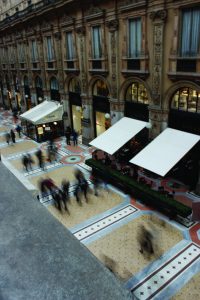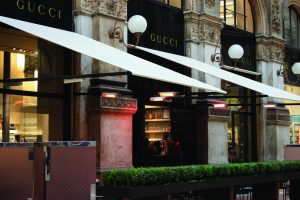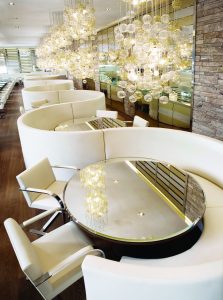Francesca Unsworth heads to Italy’s capital of fashion to discover whether sartorial elegance is just a pastime for Milan’s residents or if it has become part of everyday life
In Milan’s city centre you can’t swing a Prada bag without hitting a passer-by toting top-to-tail designer clobber. In the same way that LA is a mecca for wannabe movie stars, Milan is the ultimate destination for fashion aficionados hoping to make it in the competitive industry, whether as models or agents, stylists or designers, photographers or editors. But what sets Italy’s capital of chic apart from other European contenders, such as London and Paris, is the ubiquity of the brands. Whether it is on the 40ft-high billboards in Brera, on the crockery served in the Armani caffè or the brand-embossed sunglasses worn by each and every one of the city’s residents, young or old, rich or poor – in Milan you are bombarded by Italian designer names wherever you venture.
Milan is the designer’s Disneyland. It’s an alternate brand universe, where tourists are checking into the Bulgari Spa hotel, hipsters are dancing the night away in the Armani-owned Privé Club, and the pensioners are heading to church on a Sunday with their prayer books neatly tucked into their Gucci bags.

Like a day-long experience in Mickey Mouse’s world, the fantasy tends to rub off on you too. Unlike the naive ‘wish upon a star’ fantasies, those that result from time spent in the city of Armani are decidedly more ostentatious. It starts off harmlessly, with a hint of self-consciousness at your modest accessories. In my case this moment came in the Trussardi alla Scala café when the waiter brought over a stool upon which to perch my bag, a trick clearly intended to show-off a boldly branded Miu Miu tote, but instead revealed my bargain H&M purse to every prying eye. After a few days spent perusing the city’s fabulous stores, an overwhelming desire to possess any Milanese brand-embossed trophy encompassed me. Worryingly included in the price is a dangerous overvaluation of the worth your bank account.
Fashionable fascism
As the couture capital of Italy, hosting arguably the most influential of the world’s fashion weeks twice a year, as well as being home to fashion houses such as Armani, Dolce & Gabbana, Versace and Prada, it is hardly surprising that fashion takes centre stage for the residents. The city has been proving its credentials since the early 20th century, when the fashion houses began to build their empires that still exist to this day. Fashion and fascism may seem an unlikely match, but Benito Mussolini is oft credited as the instigator of the Italian obsession with ‘Made in Italy’, a concept which shapes Italy’s fashion climate as much in the 21st century as ever before and holds its quality and craftsmanship in the highest esteem. Patriotism is the essence of the Italian fashion culture, as consumers proudly advertise their loyalty to the national logos on their belts, glasses, purses and bags.

It’s easy to remain awe-struck by the seemingly universal attention to fashion that has seized Milan’s people, with the exception of backpack-wearing tourists who stick out like Primark in a sea of Pucci. I turned to a friend and aspiring fashion stylist for guidance in deciphering the style scene, Louise Christiansen, who left London for Milan in order to pursue a career in fashion. “The style here is a lot more elegant [than in London], and it doesn’t leave them no matter how old they are. The best time to observe them is on Sunday morning when people are filing out of church; it’s incredible how well they are all dressed. Everyone looks effortlessly elegant and chic.” Effortless maybe, but nothing that a good deal of cash, a svelte physique and a steadfast commitment to maintaining the bella figura can’t procure.
Elegance without risk-taking, unless you include the burden that brands play on these consumers’ credit, is the key to fitting into Milan’s fashion mayhem. “London is a lot more prone to up-and-coming innovative designers,” says Louise, who graduated from the prestigious Istituto Marangoni, whose alumni include Franco Moschino and Domenico Dolce. “Italian designers range from the traditional, such as Prada and Missoni to the flashy ‘total look’ ones who design an outfit that is actually intended to be worn as an outfit. When you see someone wearing the D&G belt, chances are that everything else is D&G and it was bought straight off the mannequin.” That would explain the straight-off-the-runway looks that can be seen striding down Via della Spiga: Milanese style favours the elite fashion powerhouses.
Iconic status
A number of established Italian names have secured themselves an almost iconic status in the fashion world, propelling them to everyday names. Not satisfied with making their mark on the clothes horses that parade their names about town, they have tapped into the lifestyle niche. “Italian designers have mastered the ‘total look’ concept,” says Louise. “Designers here know that everyone is obsessed and they take advantage, of course. So they will have the café, the furniture, the shoes, the club etc. because people here love to say ‘lets have a coffee at the Armani café, followed by dinner at D&G Gold, then we could go dancing at Just Cavalli’; all while wearing their designer stuff”.

Encompassing three levels of spending possibilities, the Armani store on Via Manzoni is a casebook study in the success of the ‘total look concept’ in Milan. You can check into the newly opened Armani hotel (opened March 2009), buy your clothes from the store, read the lifestyle books on the first floor, have something sweet from the dolci counter, redesign your interior at Armani casa, dine at Nobu, then finish off the night at the Privé nightclub on the lower floor, without so much as setting foot outside. The signature style of minimalist grey and white hues conjure up a pure, elegant and laid-back Zen existence, saying that all of this can be yours – you just have to buy the brand.
Guilty pleasures
Shopping has become one of the city’s most significant pastimes, which accounts for the pleasures of cruising down the city’s most notorious designer-lined streets. Tourists and locals alike are drawn to the Via Montenapoleone, Via della Spiga and the most sumptuous of them all, the Galleria Vittorio Emanuele II, to carry out their designer purchasing.

Here, the shops make an artform of the window displays, where no expense is spared in the polished brass window frames. For something a little more quirky, don’t miss the less-established shopping mecca, Corso Como, in the north of the city. Boasting the Italian equivalent of Paris’ super-chic concept store Colette, 10 Corso Como is a shrine to all things chic, never failing to inspire serious spending with its collection of goods, from scented candles to Agent Provocateur underwear, all enticingly displayed for maximum desirability.
In the midst of the current economic chaos, whether Milanese consumers are losing their taste for these luxury brands remains to be seen. Versace claims that it increased its revenue in 2008 by more than eight per cent, and Ferragamo and Ermenegildo Zegna all plan to open new stores this year. When you consider the shopping situation, things seem bleaker for luxury brands; many sales started in December, ignoring the usual start day of 3 January –never a good sign. Neither was the unprecedented 40 per cent off that some designer stores were offering on their luxury goods. If the large Italian brands go down, the industry that lies behind the luxury goods that quantify the ‘Made in Italy’ concept – thousands of small manufacturers of fashion and textiles worth an estimated €52 billion – might crumble too.
Despite the stakes, Italian designers at March’s fashion week were maintaining their flair for the flash and bringing out the bling on the catwalk, despite the markedly toned-down shows of London, New York and Paris. Hadley Freeman reported on the phenomenon for the Guardian, and awarded Roberto Cavalli the ‘Marie Antoinette prize of the month’, ‘who, a mere 72 hours after tearfully announcing that the licensing company for his secondary line, Just Cavalli, had gone into receivership held a huge party for the launch of the Cavalli MasterCard.’ It seems that the art of keeping up appearances, even in the wake of financial meltdown, applies to designers as much as consumers.
